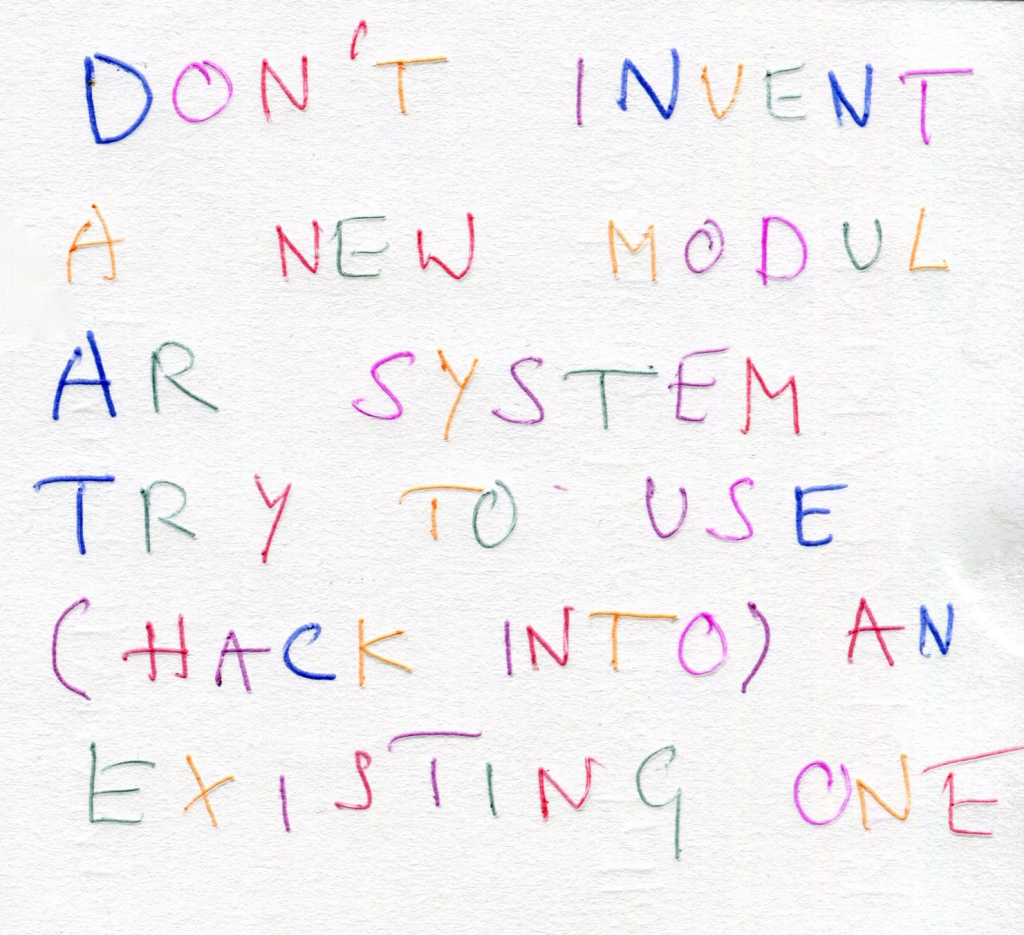Log
- Science Hack Day Berlin 2019, November 1, 2019
- Mentioned in “FabCity-Schulen”, November 8, 2019
Link
opencircularity.info/hacking-modularity
–
[ o°]
Hi,
I am an artist, designer and activist and also educator exploring openness and other design strategies for a sustainable world of products and cities pre & post climate change. We share a lot of our stuff at the page of our Design & Activism Studio Mifactori and here on Open Circularity. But for the next 9 minutes let’s just focus on one thing: Modularity.
*
Modularity & Sustainability
I am going to talk to you about modularity. Modularity is one design strategy for sustainability . It enables repair and reuse and therefor helps to reduce the production of new objects. But designers often only get half of this right. And our message to them is:
→ ARTICLE: Don’t invent a new modular system try to use (hack into) an existing one.
(Click on article just explain the free universal construction kit.)
YES! Interoperability is key!
*
Example 1 – Pre-Use
There are a several strategies we explore for this. One of it is PRE-USE.
→ ARTICLE: Pre-Use Introduction | Read more: Pre-Use-Collection on Flickr, Pre-Use Category, Pre-Use Workshop for Academics
(Explain it brief and show some images.)
→
Example 2 – Open Design @Mifactori
Another is our OPEN DESIGN research. We are going to publish a lot more info about this, but for many years we do this research on creating a lamp or any objects that are just made with standard parts
→ TALK/ARTICLE: The Mifactori Open Design Lamp
(scroll just quickly through the images.)
The idea here is to really only use standard parts you can get everywhere. And thus make sure everything is interconnectable and reusable in many many different ways.
We learned a bunch from that – what this means for the whole strategy of a product and when the new iteration is coming out we will share these insights. Some are already in the talk linked above.
→
Example 3 – Lego Meccano Hybrids
A very simple example: Drill holes into Lego and make it connectable with Meccano style parts.
→ POST: Lego Meccano Hybrids | Related: Lego Hookrails, PET-Palace
(scroll just quickly through the images of link 1.)
→
Example 4 – Circular Street Waste
Here we tried to modularize with Kids waste like furniture or plastic parts:
→ WORKSHOP HOW TO: Circular Street Waste | More like this: Transformers Workshop
–
M☉dularize ❙t!(Hacking Modularity with the help of Science)
BUT! Since we are here at Science Hack Day Berlin I made sure that another very interesting approach or project is published made to tickle also your scientific bones!
→ DOCUMENT: Criteria to rate modular solutions Version 0.1 .PAD
(go through the article explain it briefly in the time you have left)
*
Quick Summary: The project proposes a rating system for modular solutions. The solutions are rated for example after categories like how common they are, how open, how hackable, how sustainable, how upcycling friendly and so on. The higher a solution is rated the more it can be recommended to be used in your designs.
And you can increase the rating of a system through hacking! Where to focus our energy if we want to turn the world into a lego like building system that will help us to survive climate change?
This is about SCALE (the subject of this years SHDB).
*
Work with it at SHDB!
You can work with this here at SHDB! Here are a few ideas:
- Count the available modular solutions here in this room (or on the street outside). Rate them – maybe with your own much simpler rating system. Hack the solutions to play with the rating.
- More serious: Take the rating system and improve it – create a Version 0.2 – and present us an example.
- . . .
Ad
Sign up to our Newsletter to get news from us!
Visit and share our pages – Mifactori, Lars Zimmermann, Open Circularity
Follow us on Social Media (we are on a lot of channels for example as @mifactori on instagram or @bricktick on twitter.)
*
Link [ o°]
→
opencircularity.info/hacking-modularity
***
(ノಠ益ಠ)ノ彡┻━┻
